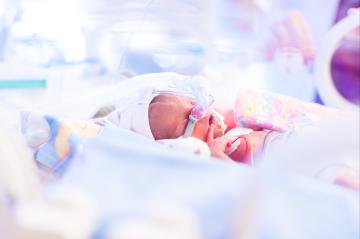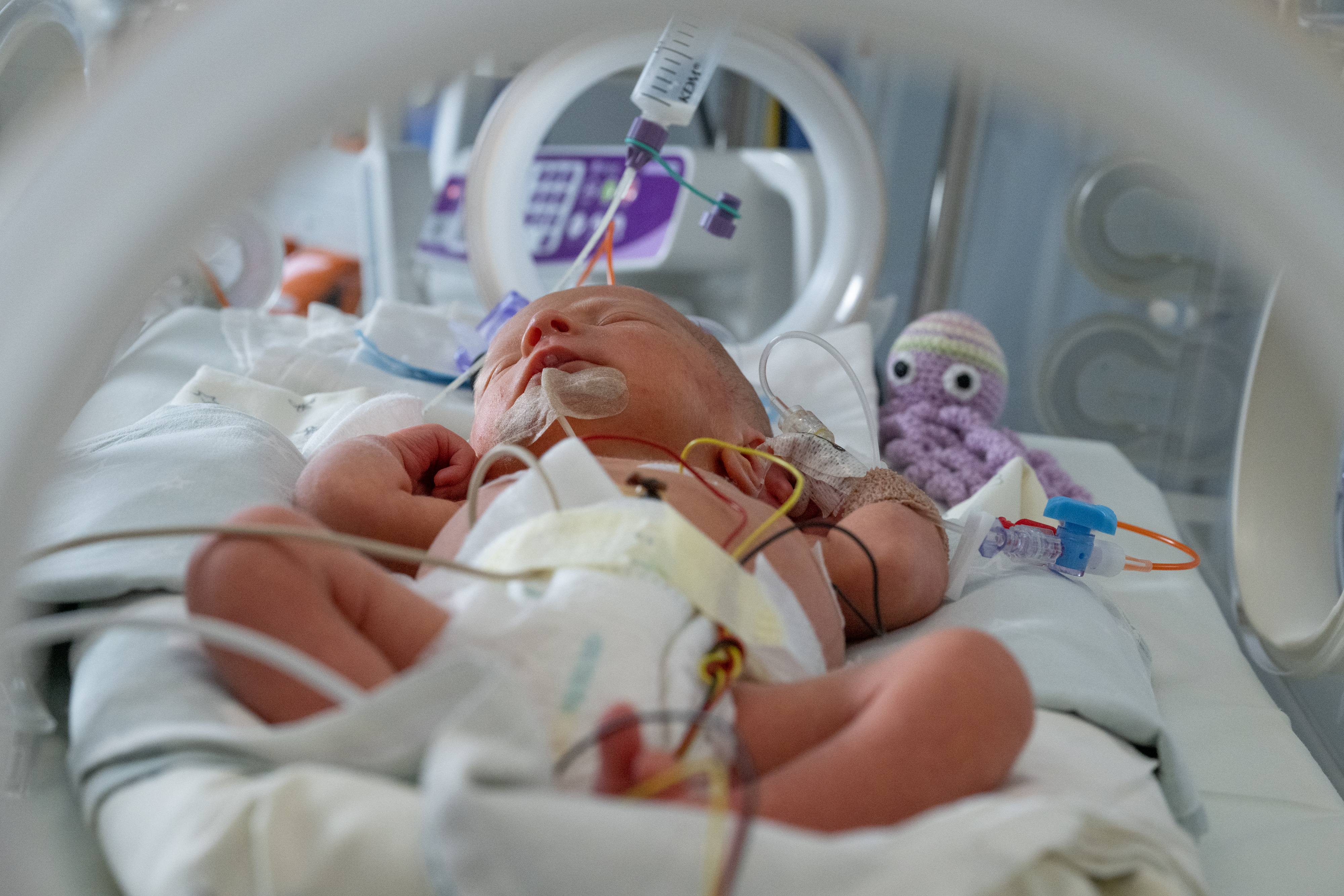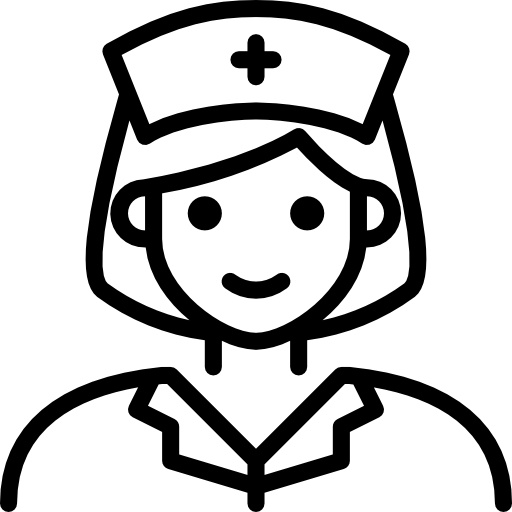Premature centre
Support for newborns with complicated and premature births

Premature centre
More than half of very premature babies in Estonia are born in the maternity ward of the East Tallinn Central Hospital, to where all cases of emergency and difficult births from North and West Estonia are referred.
Over the years, East Tallinn Central Hospital has heavily invested in its eight-bed neonatal intensive care unit and its quality of care. We started developing neonatal intensive care in our hospital in 2012 when we noticed that the condition of very premature babies was deteriorating due to immediate postnatal transport. The main objective of the treatment of very premature newborns is to minimise neonatal morbidities that can impact the child's future health and development, in particular from diseases specific to very premature babies, such as bronchopulmonary dysplasia (chronic lung disease – BPD), intracerebral haemorrhage (ICH), cystic periventricular leukomalacia (cystic lesion of cerebral white matter – cPVL), retinopathy of prematurity (eye disease caused by prematurity – ROP), and necrotising enterocolitis (inflammatory bowel disease - NEC), and to prevent serious complications and mortality. Less aggressive treatment methods in the first hours and days of the newborn’s life are significantly associated with reduced infant mortality and neonatal morbidity and have a positive impact on the child’s future health and development.
The improved outcomes have been facilitated by our breastmilk donor bank, established in 2010 as the only donor bank in Estonia, providing breastmilk to newborns in need. Donated breastmilk is given to very premature babies until their mother starts to produce a sufficient amount of breastmilk on her own.
In our hospital, we implement the mildest and safest intensive care possible to premature babies. As a result, the number of very premature newborns who were alive at the end of their initial hospitalisation and did not have any neonatal illnesses affecting the development of premature babies has increased.
Halting premature labour is crucial for the health and survival of the child. Modern evidence-based treatments are used for this – prolonging the pregnancy with medications if possible, antenatal corticosteroid therapy to prepare the foetal lungs, neuroprotection to protect the immature foetal/infant brain and anti-inflammatory treatment.

Neonatal intensive care 24/7
6207 549
Breastmilk donor bank
Breastmilk donationPremature birth
One of the most serious complications of pregnancy is labour before the 34th week.
Premature labour is defined as the onset of regular uterine contractions before the 37th week of pregnancy with simultaneous changes in the cervix (cervical dilation). This may be accompanied by the premature rupture of amniotic fluids.
It is almost impossible to predict the likelihood of premature labour in early pregnancy. Risk factors include a history of premature labour or foetal death, chronic maternal illnesses, multiple pregnancy, foetal malformations, bleeding during pregnancy, vaginal or cervical infections, premature rupture of amniotic fluids, and poor social support.
Babies born between the 22nd and 28th week of pregnancy (5th to 7th month) account for 0.4% of all live births. These babies usually weigh 500 to 1000 grams at birth. 9.3% of all babies are born between the 29th and 32nd week of pregnancy (7th to 8th month), with birth weights ranging from 1000 to 2500 grams. Approximately 80% of all premature babies are born between the 32nd and 36th week of pregnancy. Up to a quarter of premature babies are born before the 37th week of pregnancy for medical indications, such as when the health of the mother or the foetus is at risk.
The birth of a premature baby is a significant concern for the parents. Treatment of the premature baby can be very complex and long-term, which is exhausting both financially and psychologically. Premature babies often suffer from a number of serious health problems, which is why they need special monitoring and treatment. Where possible, mothers at risk of premature labour are referred to more advanced hospitals (Tallinn, Tartu). Intrauterine transport is safer for the child. The outcome of neonatal intensive care in terms of child survival and future quality of life is the best in high-level centres with the highest number of patients, which have both the necessary staff and technical infrastructure and where the required treatment expertise is pooled along with the patients.
Contact between mother and child
Parents can visit their premature newborn at any time. The neonatal intensive care unit nurse supports the mother by teaching her how to monitor, care for and feed the baby with a feeding tube.
Thanks to the skilful work of our nurses and the specialist equipment, it is possible in our hospital to leave babies who only need monitoring in a regular room with their mother. Babies who have undergone intensive care are taken to the postnatal room to their mother as soon as the condition of the baby and the mother allows.
The Neonatology Department of the Maternity Hospital of the Central Hospital works together with Tallinn Children's Hospital.
Breastmilk donor bank
In 2010, we established the first breastmilk donor bank in Estonia and the entire Baltic region to provide donated breastmilk (DBM) to meet the nutritional needs of very premature newborns. All very premature and sick newborn babies are ensured access to breastmilk immediately after birth (at the latest at two hours of life). An individualised feeding strategy (individualised determination of breast milk quantity and composition) for premature and sick newborns is one of the most crucial aspects of modern neonatal intensive care.
In 2010, we established the first breastmilk donor bank in Estonia and the entire Baltic region to provide donated breastmilk (DBM) to meet the nutritional needs of very premature newborns. All very premature and sick newborn babies are ensured access to breastmilk immediately after birth (at the latest at two hours of life). An individualised feeding strategy (individualised determination of breast milk quantity and composition) for premature and sick newborns is one of the most crucial aspects of modern neonatal intensive care.
The conditions in the breastmilk donor bank meet the requirements for processing and handling donated breast milk. First, we perform a nutrition analysis on the milk and then it’s pasteurised using a special pasteuriser.
The priority for donor milk is given to babies born very prematurely, followed by bigger premature newborns. Where possible, donor milk is also given to on-time babies who have other illnesses. As soon as the biological mother produces enough milk of her own, the administration of donor milk ends and the babies continue getting their own mother’s milk.
Donating breastmilk is voluntary and not reimbursed in any way. All donor candidates will undergo necessary testing (questionnaire, blood test) at our hospital to avoid risk of infection.
If you are ready and willing to voluntarily support little premature or sickly newborns and wish to become a breast milk donor, please fill out a printed health form and contact the breast milk donor bank advisors send an e-mail to emapiimapank@itk.ee.
Please also read the ‘Informed consent to donate breastmilk’ document, which you must sign before you become a donor.
The breastmilk donor bank is located at the East Tallinn Central Hospital Ravi Street Unit.
604
newborns treated at our maternity hospital
in 2023
212

premature babies
7

paediatricians
37

paediatric nurses
30

breastmilk donors
 Terviseportaal
Terviseportaal